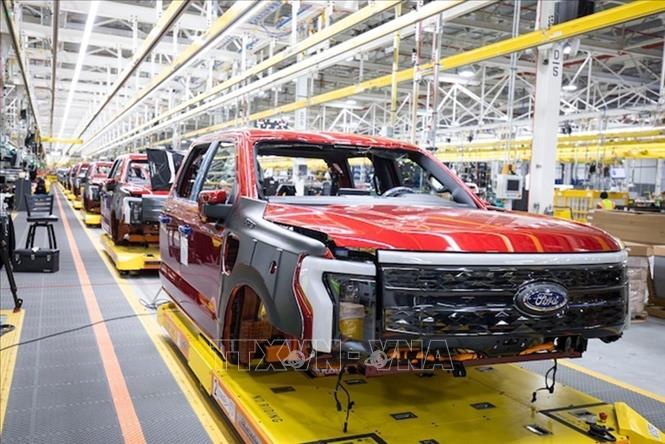
Ford’s car production line at a factory in Dearborn, Michigan (USA). Photo credit: Getty Images/TTXVN
Ford announced on February 2nd that sales increased by 4.3% in January compared to the same period in 2023. Leading the way was a 43% rise in hybrid car sales, while sales of traditional internal combustion engine cars only increased by 2.6%. Last month, Ford sold 152,617 vehicles.
The strong increase in hybrid vehicle revenue aligns with Ford’s focus on this technology. Demand for hybrids is growing, while electric vehicles like the F-150 Lightning pickup and the Mustang Mach-E crossover are selling slower than expected.
In January, sales of the Mach-E declined by 51%, while sales of the F-150 Lightning dropped by nearly 0.5%. Ford is ramping up production of the E-Transit van, which saw sales of over 1,100 vehicles in January, compared to less than 400 vehicles in the same period last year.
Although hybrids are a focus, 90% of Ford’s sales last month were traditional cars and trucks. The top-selling hybrid model was the Ford Maverick pickup, which accounted for 7.3% of total sales. Meanwhile, electric vehicle sales made up only about 3% of Ford’s January sales, with less than 5,000 units sold.
Notably, Ford’s largest vehicle segment, the F-Series pickup trucks, saw a 12% decline in sales to roughly 48,700 units last month.
Ford mentioned that it is reducing production of the F-150 Lightning electric truck due to lower expectations of electric vehicle demand in 2024.
As of April 1st, the automaker plans to cut production down to one shift at the Rouge Electric Vehicle Center. This move is expected to impact around 1,400 workers, with some being reassigned and others expected to take early retirement.
In a statement, Ford said that it expects worldwide electric vehicle sales to continue growing in 2024, although at a lower rate than previously predicted. Ford’s reduction in production is based on its goal of “achieving an optimal balance between manufacturing, revenue growth, and profitability.”
According to Ford, sales of the F-150 Lightning increased by 55% in 2023, with further growth expected this year. However, prior to this, the company had lowered the starting price of its lower-priced models by nearly $10,000.
Due to slower-than-expected growth in electric vehicle adoption in the coming years, the auto industry has scaled back previous targets.
American consumers remain wary of these vehicles, partly due to cost as well as concerns about range anxiety on longer journeys and the slow pace of nationwide charging infrastructure expansion.
On January 19th, the White House announced a new $325 million investment, in part to help repair and replace electric vehicle chargers nationwide.
Automotive research firm Edmunds predicts that electric vehicles will capture an 8% share of US vehicle sales by 2024, up from 6.9% in 2023.
Industry data shows that foreign automakers are increasing exports from China, the world’s largest automobile market, as their market share is gradually being eroded by local competitors. Foreign automakers accounted for over 20% of China’s total automobile exports in 2023.
China is forecast to surpass Japan and become the world’s largest auto exporter in 2023, largely due to the rapid development of domestic companies such as Chery, SAIC, Geely, and BYD.
Meanwhile, data from the China Association of Automobile Manufacturers (CAAM) shows that 18 foreign brands, led by Tesla, exported a total of 910,000 vehicles from China in 2023, accounting for 22% of the country’s total export volume of 4.1 million vehicles.
Tesla alone exported 344,000 electric vehicles from its factory in Shanghai, the largest plant of its kind globally, to markets in Asia, Europe, Australia, and New Zealand. Ford Motor and General Motors are also among the top exporters, with the total number of vehicles exported by these companies increasing by 21% since 2022.
Meanwhile, these manufacturers have also planned to invest a total of $616 billion in electrification by 2027, doubling the level of allocation estimated just two years ago. Indeed, many manufacturers have recently announced adjustments to their energy transition strategies.
According to Dario Duse, Managing Director and Italy Market Leader at consulting firm AlixPartners, “There is currently an adjustment in growth expectations, given the uncertain economic situation, the practical implementation of European emissions regulations, purchasing costs, and the pace of electric charging infrastructure upgrades.”












